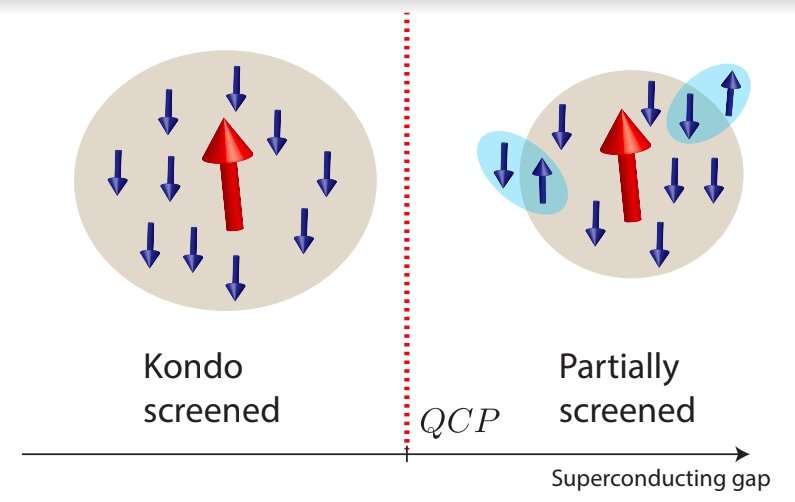Credit: Paşcu Moca.
In recent years, many physicists worldwide have been investigating the behavior of hybrid nanostructures. These are systems that are typically made up of two or more materials. Special attention in this class of structures is paid to magnetic impurities interacting with superconducting and normal metallic contacts.
Past studies have found that when a metal contains magnetic impurities, conduction electrons can form a screening cloud, which essentially screens the impurity's spin. This physical phenomenon is known as the Kondo effect; thus, the resulting cloud is referred to as a Kondo cloud.
While the behavior of the Kondo cloud in normal systems is well-understood, its properties in the presence of superconducting materials have not yet been explored in depth. So far, most physicists have believed that the screening of impurity spins in hybrid nanostructures takes place predominantly in the screened, rather than in the unscreened, quantum phase. Researchers at Budapest University of Technology and Economics in Hungary and Adam Mickiewicz University in Poland, however, have recently showed that while the Kondo state does not form in the unscreened phase, Kondo clouds exist in both screened and unscreened quantum phases.
"When one considers a single spin S=1/2 impurity, such as a quantum dot or a molecule, attached to a metallic contact, a correlated Kondo state forms in such systems at sufficiently low temperatures," Ireneusz Weymann, one of the researchers who carried out the study, told Phys.org. "In such a state, the impurity's spin is screened by the conduction electrons and a correlation cloud (so-called Kondo cloud) is formed around the impurity."
While several researchers examined the properties of Kondo clouds, only recently have teams also started probing these systems experimentally. One of the most notable experimental studies was conducted by Ivan V. Borzenets at City University of Hong Kong and his colleagues at other institutes worldwide. The recent paper by Weymann and his colleagues, published in Physical Review Letters, builds on this previous work to shed light on the behavior of Kondo clouds in superconductors.
"Understanding the spatial extension of various states is important to understand the fundamental aspects of strong electron correlations, which is relevant for various correlated materials," Weymann explained.
The recent work by Weymann and his colleagues is of a purely theoretical nature, as they employed state-of-the-art numerical and analytical renormalization group methods. These techniques allowed them to accurately predict the behavior of a Kondo cloud inside a superconducting material.
"The system we considered exhibits a quantum phase transition when the ground state changes between the Kondo state and the so-called Shiba state," Weymann said. "Up to now, it was believed that the screening occurs in the Kondo phase. Quite strikingly, we have however, demonstrated that the Kondo cloud exists also in the unscreened phase."
The results of the analyses and calculations carried out by this team of researchers also suggest that the properties of Kondo clouds are universal and exhibit a characteristic jump at the so-called quantum critical point. In the future, their work could inform a series of experiments directly investigating the properties of Kondo clouds in superconductors.
"We now plan to extend our work to more complex systems, where more exotic ground states could be realized," Weymann added.
More information: Cătălin Paşcu Moca et al, Kondo Cloud in a Superconductor, Physical Review Letters (2021). DOI: 10.1103/PhysRevLett.127.186804
Ivan V. Borzenets et al, Observation of the Kondo screening cloud, Nature (2020). DOI: 10.1038/s41586-020-2058-6
Journal information: Nature , Physical Review Letters
© 2021 Science X Network
























